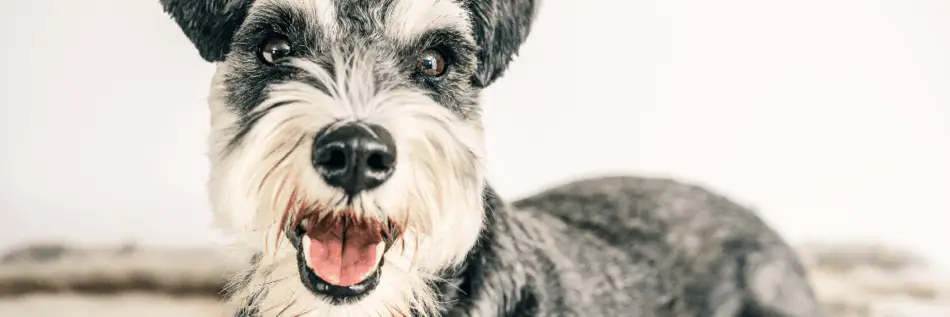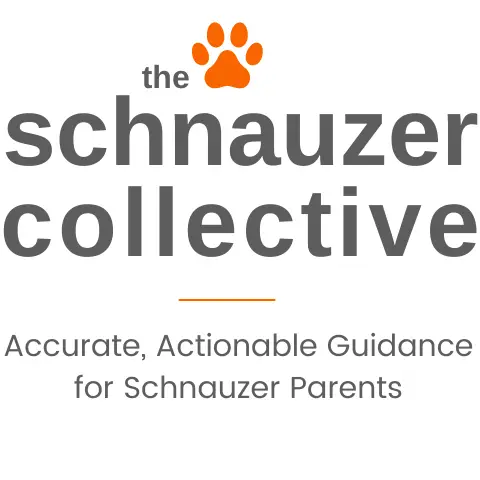
FAMILY FRIENDLY

INTELLIGENT

HEALTHY

EXERCISE NEEDS

GROOMING NEEDS

HYPOALLERGENIC









- Height: 10-24 inches
- Weight: 10-20 pounds
- Lifespan: 10-16 years
- Food: 3/4 – 1 cup each day, spread over two meals
- Intelligence: Ranked in the top 12 of 140 dogs
- Popularity: Ranked 18th out of 190 dogs
Physical Description
Miniature Schnauzers are small, terrier-like dogs with strong, well-developed muscles, square body frames, and a distinctly rectangular head. Miniatures can be bred will smaller breeds to create “teacup” sizes, but regardless of actual size, all are considered to be Miniature Schnauzers.
The Miniature Schnauzer has a thick double coat. The undercoat is soft and dense, while the outer coat is wavy, sometimes even curly, and somewhat rough. A wiry beard and eyebrows are recognizable, iconic features of the Miniature Schnauzer.
The three colors allowed for the Miniature Schnauzer are solid black, salt and pepper, or black and silver. New custom colors can include fawn, and “parti” (particularly colored) colors featuring a white base with spots or bands of other colors, such as black.
A Miniature Schnauzer’s ears may be cropped or left floppy and natural. His tail may be docked or natural. Meeting AKC breed standards and showing requirements include a docked tail.
Temperament
Miniature Schnauzers are quick-minded and alert, always eager to please and anxious to learn new skills and tricks. This spunky breed is ranked as one of the most intelligent dogs and will entertain you with his sharp mind and fun personality. The Miniature Schnauzer is playful and energetic, while also loving and cuddly. Miniature Schnauzers do not like being alone and usually prefer a special relationship and bond with their human companions.
Here are several specific layers to a Miniature Schnauzer’s general temperament.
Temperament: Guard Dog Instincts
Giant Schnauzers were originally bred to hunt rats and other small rodents on German farms. Because of their genetic heritage stemming from their cousins, the Standard Schnauzer, they also have some guard dog instincts that include barking at perceived intruders or danger.
Like all Schnauzers, Miniature Schnauzers can be territorial of their surroundings and protective of their human family. While they are not bred to be overly aggressive, Miniatures will bark at strangers or unfamiliar animals.
Within their guard dog instincts, however, they can be trained and socialized to blend well into families and social situations. Their small size makes any territorial tendencies manageable, and rather than being aggressive, Miniatures are naturally loving animals.
Temperament: Family and Other Pets
Miniature Schnauzers are genetically inclined to be with a human family. Stemming from their early days serving on German farms and due to breeding for a specific role and temperament, Miniature Schnauzers thrive within an active, loving family environment.
Read my article Are Schnauzers Affectionate? for additional family information.
Miniature Schnauzers are naturally protective of their human families and crave human interaction. Because they are an intelligent breed, they can be a little feisty, insistent, and stubborn, but early training and socialization will help.
How Are Miniature Schnauzers with Kids?
Miniature Schnauzers are the most “cuddly” of the Schnauzer breeds. They will generally sidle right up next to you on the bed or couch and make themselves comfortable either near you, or even on you. Their downtime may be spent quietly relaxing with you like a best friend.
This isn’t to say that Miniatures are lap dogs, however. They are much too active for that. They still need a lot of activity and exercise, and they also show much of their affection through play. Their size makes play manageable and their intelligence makes new games a great outlet for them. They are prone to display affection through antics and fun.
As such, Miniature Schnauzers are generally very good with kids. However, small children should always be supervised.
How Are Miniature Schnauzers with Aging Adults?
Miniature Schnauzers can also be great companions for aging adults. As affectionate, intelligent dogs, Miniatures can provide company, emotional support, and peace of mind. They can also be trained as therapy dogs and some may be certified as service dogs depending on the needed skillsets. The drawback is their size. For some aging adults, a Miniature Schnauzer (especially the “tea cup” sizes) might get underfoot and cause tripping or falling hazards. Overall, however, Miniature Schnauzers can provide genuine companionship and love.
Read my article Can Schnauzers be Therapy or Service Dogs? for additional details.
How Are Miniature Schnauzers with Other Pets?
If trained and socialized early, Miniature Schnauzers can do quite well with other dogs and even cats. However, they can also be quite territorial if they are not socialized to other animals and pets early. In addition, Miniatures were bred to hunt small rodents and the instinct can still come into play. It is necessary to monitor a Miniature Schnauzer’s reaction to small pets and possibly simply keep them apart. It’s never advisable to leave a Miniature Schnauzer alone with a very small, rodent-like pet.
Check out my article Do Schnauzers Get Along with Other Dogs (And with Cats?) for some insights into Miniature Schnauzers and other animals.
Socialization
The best way to ensure that a Miniature Schnauzer does well with the other people and animals in your life is to train and socialize early.
Begin socializing a Miniature as early as possible by introducing him to a range of people and experiences.
Socialize him in a wide variety of ways by getting out to parks, trails, pet-friendly events, and pet-friendly buildings where he will encounter people. Continue inviting friends and family to your home. Let them know that you have a Miniature Schnauzer and that it may take a few visits before he warms up to them.
Intelligence
Miniature Schnauzers are currently ranked as the 12th most intelligent dog breed out of a total of 140 breeds. Miniatures learn quickly, and can be very obedient dogs when they are kept mentally and physically active. They can generally learn new commands within 5-15 repetitions and perform commands with a success rate of 85% or better.
However, intelligence comes with some potential drawbacks such as willfulness. Early, consistent, and firm but positive training will ensure that a Miniature Schnauzer’s intelligence is channeled in healthy and mutually enjoyable and productive ways.
Read my article Are Schnauzer’s Smart? How to Tell and 5 At-Home Tests for more information.
Best Living Conditions
The Miniature Schnauzer is intended to live indoors with a family. A Miniature can be left alone for several hours or so if they are fully crate trained, potty trained, comfortable in the home, and left with moderately challenging dog toys. However, Miniatures are intelligent, busy, active dogs and can easily become bored and destructive.
The Miniature Schnauzer is an adaptable dog and can comfortably live in a city apartment just as they would do on a country farm, as long as they get adequate exercise every day. While they may prefer living on open land or somewhere they can easily run, Miniatures can also live in smaller dwellings.
Access to trails, open spaces, or dog parks is ideal. In addition, a fenced yard is usually recommended because they are known to jump a five-foot fence.
Whatever its environment, the Miniature Schnauzer should live with its human family.
Training
Ranked as a highly intelligent canine breed, the Miniature Schnauzer can generally learn new commands within 5-15 repetitions. As very energetic and bright dogs, Miniature Schnauzers genuinely enjoy both the mental and physical challenge of learning new skills.
In addition, the sometimes-mischievous, spunky, intelligent, and willful Miniature Schnauzer needs to know who is in charge. Any owner who wants a good experience with a Miniature will need to begin training early, be consistent, establish authority, and employ firm, but positive training.
Basic Commands
The 16 basic commands below are essential skills a Miniature Schnauzer can and should have. Enlisting the help of a professional trainer or purchasing a training program can provide a solid, successful start.

Keep in mind that training these skills should be for respect and obedience, not just for fun:
| Watch Me | Wait | Off | Settle |
| Sit | Down | Leave It | Place/Bed/Crate |
| Stay | Heel | Take It | Stand |
| Come | No | Drop It | No Pull |
Training Tips
Scheduling a series of sessions with a professional dog trainer may give you the confidence and first-hand training observation you need to continue training your Miniature Schnauzer for life.

Whether you involve a professional trainer or not, here are some basic training tips:
- Find a quiet, private location with no distractions
- Show him exactly what your want him to do
- Teach one command at a time and move to another command only when he has mastered the first one
- Reward progress with small treats
- Don’t punish him for mistakes
- Keep the training sessions short and simple
- Be patient and consistent
- Stay upbeat and positive
- Keep trainings fun and full of encouragement
- Include play sessions after the training to keep training associated with fun and loving interaction
Respect Training
Miniature Schnauzers need to respect their human caretakers. They are intelligent and active enough to be hard to handle if they are not trained to respect humans. The training can be positive, but firm and consistent. Consider partnering with a professional trainer early in the process.
Sport Training
Bred as farm ratters who rid areas of small rodents, Miniature Schnauzers have medium to high energy levels and a need for regular exercise. It is essential to establish a routine that includes walks and games to keep him mentally and physically active. Also, fetch and tug games, and runs in fenced-in yards helps to meet these needs. Their ability to learn, and a constant desire to chase, makes the Miniature Schnauzers well-suited for dog sports.
Miniature Schnauzers are extremely agile, strong, and have excellent endurance. Miniatures have a running speed of 20 MPH and a jumping height of 4-5 Feet.
They excel at many canine sports such as Agility Training, Obedience, Earth Dog Trials, and Barn Hunt.
Read my article What are the Best Sports for Schnauzers? for a comprehensive list of sports and for ways to keep your athletic Standard Schnauzer healthy.
Therapy and Service Training
Schnauzers have therapeutic effects on the physical and psychological conditions people might experience. They are loving and intelligent, and can be trained as either therapy or service dogs.
As well-trained therapy dogs, Miniature Schnauzers can bring comfort and affection to people in health institutions, schools, retirement homes, among other places. As potential service dogs with very specific tasks, Miniatures can help physically challenged people to live a more independent and freedom-filled life.
For more details on how Miniature Schnauzers can serve in these capacities, read my article Can Schnauzers be Therapy or Service Dogs?
Grooming
Miniature Schnauzers have consistent grooming needs. Keeping up on basic grooming tasks will ensure that he is maintained well and that any health issues are caught early.
Hypoallergenic Coat
The Miniature Schnauzer is born with a double, wiry coat and is considered to be hypoallergenic. Their covering is more like human hair than animal fur, and they don’t shed any more than a human being does.
This keeps pet dander to a minimum and is perfect for anyone with allergies. However, it also means that the Miniature needs to be brushed and groomed regularly.
The Miniature Schnauzer will need its longer hair brushed several times a week, and the beard should be cleaned and brushed daily. He should be fully bathed weekly unless it seems like the skin is becoming dry and flaky.
This breed’s coat must be hand-stripped at least every four to six months if you like the look and feel of its original coat or decide to show your dog.
However, if you are not interested in having a show dog, it is also an option to use clippers to shave the outer coat. Using clippers to remove the outer, wiry coat is becoming a more popular option because it reveals the softer undercoat. If you are not showing your Miniature, how you groom his coat comes down to personal preference.
Teeth
Historically, all Schnauzer breeds have teeth that are more susceptible to periodontal disease than other dog breeds. Without regular brushing, tartar and plaque will accumulate leading to tooth decay, infections, bad breath, gum disease, tooth loss, and gingivitis. When left untreated, gingivitis can progress into periodontal disease leading to severe health problems.
According to the American Veterinary Dental Society, 80% of canines develop periodontal illness by the age of three. The Giant Schnauzer’s gums will start breaking down due to periodontal disease, increasing the risks of harmful bacteria entering the bloodstream. Once bacteria enter the bloodstream, the immune system may be compromised and can eventually lead to organ failure.
In addition, Miniature Schnauzers with poor dental hygiene are more prone to eye problems, joint problems, liver disease, kidney disease, and heart disease.
It is necessary to brush a Miniature’s teeth several times weekly, preferably daily. Chew toys and an enzymatic water additive formulated to help reduce tartar can help with hygiene. An annual periodontal examination by his veterinarian and possibly a professional veterinary cleaning (which requires full anesthesia) are basic recommendations.
How To Clean Your Schnauzer’s Teeth
Brushing your dog’s teeth is one of the most significant things you can do to prolong his life. Doing it every day will help prevent the accumulation of tartar and plaque, which might otherwise develop into periodontal disease. You should start brushing the teeth of your Schnauzer daily when it’s a small puppy. That will assist in stimulating its gum lines and also help it become comfortable and accept the process of having regular dental cleanings.

Here is a step-by-step guide on how to clean your Schnauzer’s teeth.
| 1. Set a specific time during the day | Choose some time during the day that works best for you, but it’s always a good idea to set a time of day when your dog is relaxed and calm. Whatever time you select, try, and keep it as part of your routine each day because cleaning dog teeth daily is the most effective to maintain good dental health. |
| 2. Choose a comfortable spot | Select a convenient location for both of you. For instance, you can have your dog lie on a couch or the bed. That way, you can easily clean one side of its mouth and then turn it over to brush the other side more easily. |
| 3. Collect your brushing tools | Make sure you have everything ready before you begin brushing your schnauzer’s teeth. Apart from the toothbrush and toothpaste designed for canines, you can also have a washcloth to help you hold back the wet open mouth of your dog. Note: Only use a canine-approved toothpaste! Canine toothpastes are formulated to be safe for dogs and swallowed without causing harm. Human toothpaste is toxic for your Schnauzer. |
| 4. Inspect your Schnauzer’s teeth | Begin the cleaning process by giving your dog a good oral examination. Lift the lip of your Schnauzer and look at its teeth. Check for any signs of tartar, plaque, gum disease, or tooth decay. |
| 5. Inspect your Schnauzer’s mouth | Place your thumbs gently on either side of the Schnauzer’s muzzle and lightly stoke downward. Check if there any abnormalities or lumps. Also, check the gum lines of your dog. The gums should not be swollen and must be pink in color, not red. |
| 6. Begin brushing his teeth | 1. Put a small amount of gel or toothpaste on the finger brush or toothbrush. Next, pull the corner of your dog’s mouth backward using your thumb to lower and press down the bottom lip and your index finger to raise the top lip. 2. Start brushing at the back of its mouth and begin with gentle back-and-forth strokes. Avoid applying too much pressure because it can cause damages to the gum line, making your Schnauzer squirm to get free. 3. Utilize light pressure at all times because you want your pet to accept the cleaning process. Clean the upper and lower teeth, spending 30-40 seconds on each section. |
If your Schnauzer pulls away in pain or his gums bleed at all during the brushing process, make an appointment with your veterinarian as soon as possible.
Read my article Your Schnauzer Has Genetically Bad Teeth! (What to Do) for details on periodontal disease and how to take care of your Schnauzer’s teeth.
Eyes and Ears
A Miniature Schnauzer’s eyes and ears are two of his most important and excellent senses. Checking them regularly and keeping them healthy is critical.
Eyes
Schnauzer eyes tend to build up black discharge at the inner corners and they need to be gently washed with warm water and a cloth nearly daily. Read my article Why Does My Schnauzer Have Eye Gunk (And What to Do) for details. Miniature Schnauzers are also prone to specific eye problems, such as cataracts. The eyes should be inspected regularly to catch health problems early. Read my article Can Schnauzers Get Cataracts (10 Eye Problems to Know About!) for important information.
Ears
Miniature Schnauzer ears can either be left natural and floppy or they can be trimmed (docked) when they are very young. Either way, they need to be inspected and gently washed regularly to keep moisture, dirt, earwax, and ultimately, bacteria at bay. Some owners and groomers even pluck the ear hair as part of normal grooming, although if the ears are healthy there is no medical reason to do this. Read about this somewhat controversial practice, along with basic ear hygiene in my article Should I Pluck My Schnauzer’s Ears (If so, Why and How?).
Health
Like many purebred dogs, Schnauzers are vulnerable to some health problems that are inherited genetic weaknesses. Of the three breeds, Miniature Schnauzers are more vulnerable to health issues than Giant and Standard Schnauzers. Miniatures are the most recent Schnauzer breed and are susceptible to pancreatitis, diabetes, cataracts, and bladder or kidney stones.
However, keeping up a healthy diet, exercise, vaccinations will help to extend the length a quality of a Miniature Schnauzer’s life.
Immunizations
All canine immunizations fall into two categories: Core and Non-Core.
All dogs are required to stay on a core vaccination schedule.
The non-core vaccinations are optional depending on your Miniature Schnauzer’s particular health risks, and your veterinarian can provide some guidance.
Core vaccinations include:
- Canine DAP (Distemper, Adenovirus, Parvovirus)
- Canine Rabies vaccine
Non-core, optional vaccinations include:
- Bordetella Bronchiseptica vaccine
- Parainfluenza vaccine (often combined with either the Bordetella or the DAP vaccines)
- Canine Influenza vaccine (H3N2 and/or H3N8)
- Leptospirosis vaccine
- Lyme vaccine
Miniature Schnauzer Puppy Immunization Schedule
| AGE | CORE VACCINES | NON-CORE VACCINES |
|---|---|---|
| 6-8 Weeks | – DAP | – Bordetella – Parainfluenza (often included in DAP combo vaccine) |
| 10-12 Weeks | – DAP | – Leptospirosis – Lyme – Canine influenza |
| 14-16 Weeks | – DAP: Generally given 16 weeks or later – Rabies vaccine: Some states may require it to be given earlier. Check with your state. | – Leptospirosis – Lyme – Canine influenza |
Miniature Schnauzer Adult Immunization Schedule
| TIMEFRAME | CORE VACCINES | NON-CORE VACCINES |
|---|---|---|
| Annually | None, although some states require annual rabies shots. Check with your state. | – Leptospirosis – Lyme – Canine influenza – Bordetella (sometimes every 6 months) |
| Every 3 Years | – DAP – Rabies (check with your state) | None |
Primary Health Concerns
Miniature Schnauzers, unfortunately, suffer from more health concerns that their larger counterparts. They are the most recent breed of Schnauzer and have a lifespan of between 12-16 years.
Cushing’s Disease
Cushing’s Disease is more common in Miniature Schnauzers between 6-8 years. The condition results when the pituitary gland over-secretes adrenal cortex hormones. The leading cause is either excessive steroid medications or a genetic defect. The main symptoms of the disease include a thinning coat and weight gain.
Mycobacterium Avium (AVB)
This is a severe bacterial infection affecting Miniature Schnauzers which is mostly misdiagnosed in Miniature Schnauzers. The symptoms of this infection are similar to lymphatic cancer. The dog will lack appetite, experience diarrhea, vomiting, and lameness.
Eye Diseases
Myotonia congenita and retinal atrophy are some of the common eye conditions affecting Miniature Schnauzers. If you’re a breeder, it’s essential to carry out genetic tests to determine if the parent Schnauzer is a carrier of any hereditary conditions. These eye conditions inflict gradual blindness that starts in a young Miniature and advances as it ages.
Hypothyroidism
Miniature Schnauzers may also suffer hypothyroidism when they are unable to secrete adequate amounts of thyroid hormone. The symptoms of this disease include depression, lethargy, chronic skin, and ear infections, and weight gain. Your Miniature may lack the ability to tolerate colder temperatures.
Genetic-Specific Concerns
Miniature Schnauzers suffer several genetic health issues. Most of these health issues affecting Schnauzers can be controlled during breeding. They include cataracts, progressive retinal atrophy (PRA), and liver shunt. If puppies are born with these conditions, you will need to seek veterinary treatment.
Additional Miniature Schnauzer Health Concerns
- Canine Diabetes
- Canine Pancreatitis
- Follicular Dermatitis (Schnauzer Bumps or Comedone Syndrome)
- Heart Disease
The Costs of Owning a Miniature Schnauzer
Initial Purchase
The initial purchase of a Miniature Schnauzer can range approximately between $875 to over $5,500.
The initial cost depends on what you are looking for in this breed. If you are looking for a superior pedigree and breeding lines for the purpose of having breeding rights or purchasing a show-worthy Miniature, expect to pay a premium.
Median Price: $875.00
Average Price: $900.00
Top Quality: $3,000.00 to $5,500.00
Annual Costs
The annual costs below are approximate and do not take into account price fluctuations over time or variations in your geographical location.
The costs include ranges representing personal purchase preferences and the varying cost of services depending on the service provider you choose.
| Spay/Neuter | $100 (one-time cost) |
| Vaccinations | $100 |
| Annual Checkup | $150 |
| Dental Cleaning | $300+ (as needed) |
| Flea, Tick, and Heartworm Medication | $300 |
| Health Remedies and Supplements | $50-$250 |
| First Aid and Misc. Hygiene Supplies | $50-$100 |
| Grooming | $600+ |
| Quality Food | $600+ |
| Insurance | $30-100 |
| Microchip & Monthly Service | $45 for Microchip, then $45-$120 annual registry fee |
| Training | $100-$500 + (as needed) |
| Crate, Kennel, Carrier | $35 (basic) to $1,000+ (decorative) |
| Gates | $35-$150 |
| Bed | $35 (basic) to $1,00+ (decorative) |
| Collar, Leash, Tags | $35-$50 |
| Toys, Sports, Treat Puzzles | $35-$300 (oftentimes a one-time purchase) |
| Treats | $35-$100 |
| Wireless Fence | $200-$300 (one-time purchase) |
| Misc. Expenses | $50-$100 |
In addition to the ongoing, essential costs of owning a Miniature Schnauzer, keep in mind that injuries and unexpected health issues can arise. The veterinary and animal hospital care for these situations can range between $500-$5,000 depending on the needed medical treatment.
As a pure breed dog, Miniature Schnauzers are good candidates for pet insurance due to known health issues. Although Miniatures are moderately healthy, having pet insurance can give you peace of mind.
Selecting a Reputable Breeder
Miniature Schnauzers are expensive breeds and come with significant responsibility. The decision to select a breeder and purchase a Miniature are important. You can consult the American Kennel Club for a list of registered breeders near you to begin your search.
It is also wise to continue learning about Miniature Schnauzers so that you can ask informed questions of breeders. Reputable breeders will be more than willing to meet with you, answer all of your questions, and let you interact with the dogs.
A reputable breeder will also have proof and documentation of the Schnauzer’s lineage, genetic health screenings, and immunizations or training already completed.
Selecting a Veterinarian
The American Animal Hospital Association (AAHA) evaluates veterinary practices on the quality of their facilities, staff, equipment and patient care. Look to the association for a list of accredited vets in your area. In addition, you should start looking for a veterinarian before you even purchase a Schnauzer.
You will want to ensure that the veterinarian is licensed by the AAHA and has a good track record of patient reviews and feedback. You should also visit several veterinarian offices so that you a some comparison points. Ask about what services they provide, the level of expertise of their staff, and which services they can provide at their office as opposed to at an animal hospital. Be sure that the office is clean and well-maintained, and that it feels like a good fit for you and your Schnauzer. You can also change veterinarians if you are not happy with their service.
Breed History
Historical Details
The Miniature Schnauzer is known to be an affectionate, humorous, and friendly dog. It is the smaller version of Standard Schnauzer, and it originated in 19th century Germany. The Miniature is a crossbreed between the Standard Schnauzer and smaller breeds such as the Affenpinscher, and possibly Poodles.
Miniature Schnauzers were bred to be a farm companion to the Standard Schnauzer and use its smaller size to burrow into small places, seeking out rats and other rodents. Miniatures’ breeding resulted in a strong, intelligent, resourceful hunter who is also protective and loving toward his human family.
Current-Day Roles
Presently, Miniature Schnauzers continue to play an important role in human life. Although they are a much more domesticated indoor dog, Miniatures are still genetically predisposed to love activity and work. They can be trained as Service or Therapy dogs as well as be specifically trained to detect disease. They primarily serve as loving, loyal companions.
And finally, from one pet parent to another, discover my all-time favorite resources designed to cover your every Schnauzer need. I’ve done the legwork for you so you can spend more time with the people and fur friends in your life.
A portion of all profit earned on this site is donated to Pet Partners
whose mission is to improve human health and
well-being through the human-animal bond.
They train and register pets to become therapy animals,
and have local chapters in many states.
